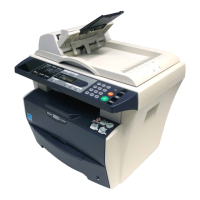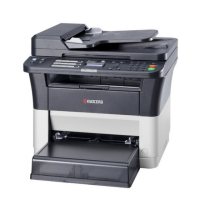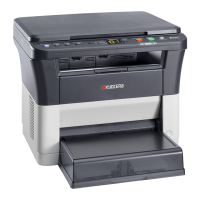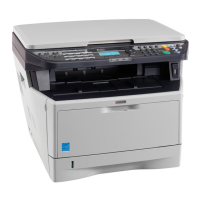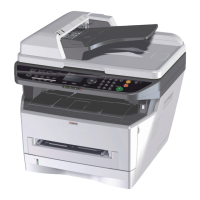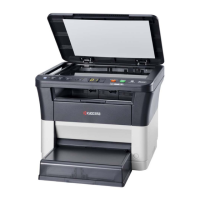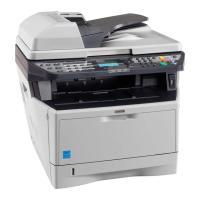How to fix improperly printed documents on Kyocera Printer?
- KkarladavisSep 10, 2025
If documents are printed improperly by your Kyocera Printer, check that the printing system driver and application software settings are set properly on your PC.
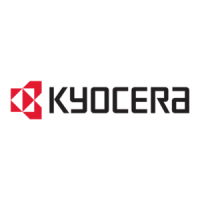
How to fix improperly printed documents on Kyocera Printer?
If documents are printed improperly by your Kyocera Printer, check that the printing system driver and application software settings are set properly on your PC.
How to fix Kyocera Printer cannot feed originals?
If your Kyocera Printer cannot feed originals, when placing originals in the document processor, align the original width guides securely before placing the originals.
Why does my Kyocera Printer paper often jam?
Paper jams in your Kyocera Printer can occur due to several reasons. Ensure the paper is loaded correctly. If it is a supported type and in good condition, try removing it, turning it over, and reloading it. Replace any curled, folded, or wrinkled paper with new paper. Also, check for and remove any loose scraps or jammed paper inside the machine.
How to remove moire pattern from Kyocera Printer copies?
If copies from your Kyocera Printer have a moire pattern, and the original is a printed photograph, set the image quality to [Photo].
What to do if pressing Start key on Kyocera Printer does not produce copies?
If pressing the Start key on your Kyocera Printer does not produce copies, check the Message Display for any messages and respond accordingly. Also, check if the machine is in Sleep mode; if so, press any key on the operation panel to recover the machine. It will be ready to copy within 15 seconds.
Why are Kyocera Printer printouts wrinkled?
If the printouts from your Kyocera Printer are wrinkled or curled, the paper might be damp. Replace the paper with new paper.
Why are images skewed on my Kyocera Printer?
If images are skewed when using your Kyocera Printer, check that the originals are placed correctly. When using the platen, align them with the slit glass. When using the document processor, align the original width guides securely before placing the originals. Also, ensure the paper is loaded correctly by checking the position of the paper width guides.
How to fix Kyocera Printer operation panel not responding?
If the operation panel of your Kyocera Printer does not respond when the power switch is turned on, ensure that the power cord is plugged into an AC outlet.
How to adjust darkness on Kyocera Printer printouts?
If the printouts from your Kyocera Printer are too dark, check if the machine is in Auto Density mode and set the correct density level. Also, verify if the machine is in Manual Density mode and select the correct density level.
How to fix light printouts on Kyocera Printer?
If the printouts from your Kyocera Printer are too light, verify that the machine is not in Manual Density mode and select the correct density level if needed. Shake the toner container from side to side to evenly distribute the toner. If there's a message indicating the need for more toner, replace the toner container. Ensure the paper isn't damp and replace it if it is. Disable EcoPrint mode if it's enabled. Also, make sure the paper type setting matches the paper being used.
| Secure printing | Yes |
|---|---|
| Print technology | Laser |
| Maximum resolution | 1800 x 600 DPI |
| Duplex printing mode | Auto |
| Time to first page (black, normal) | 6 s |
| Print speed (black, normal quality, A4/US Letter) | 30 ppm |
| Digital sender | No |
| Printing colors | Black |
| Maximum duty cycle | 20000 pages per month |
| Number of print cartridges | 1 |
| Page description languages | Epson LQ, IBM ProPrinter, Microsoft XPS, PCL 5c, PCL 6, PCL XL, PostScript 3 |
| Copier resize | 25 - 400 % |
| Maximum copy resolution | 600 x 600 DPI |
| Maximum number of copies | 999 copies |
| N-in-1 copy function (N=) | 2, 4 |
| Time to first copy (black, normal) | 6.9 s |
| Scan to | E-mail, File, FTP, Image, OCR, USB |
| Scan drivers | TWAIN, WIA |
| Scanner type | Flatbed scanner |
| Grayscale levels | 256 |
| Maximum scan area | Legal (216 x 356) mm |
| Image formats supported | JPG, TIF |
| Document formats supported | |
| Paper input type | Cassette, Paper tray |
| Total input capacity | 300 sheets |
| Total output capacity | - sheets |
| Maximum input capacity | 800 sheets |
| Total number of input trays | 2 |
| Maximum number of input trays | 4 |
| Multi-Purpose tray input capacity | 50 sheets |
| Custom media width | 70 - 216 mm |
| Maximum print size | 216 x 356 mm |
| Custom media length | 148 - 356 mm |
| Duplex media weight | 60 - 105 g/m² |
| Paper tray media types | Plain paper |
| Paper tray media weight | 60 - 120 g/m² |
| Non-ISO print media sizes | Folio |
| ISO A-series sizes (A0...A9) | A4, A5, A6 |
| ISO B-series sizes (B0...B9) | B5 |
| Multi-purpose tray media types | Envelopes |
| Maximum ISO A-series paper size | A4 |
| Multi-Purpose Tray media weight | 60 - 220 g/m² |
| Display | LCD |
| Product color | Black, White |
| Market positioning | Business |
| Display number of lines | 5 lines |
| Standard interfaces | Ethernet, USB 2.0 |
| Mobile printing technologies | Not supported |
| Processor model | 440 |
| Processor family | PowerPC |
| Compatible memory cards | CF |
| Maximum internal memory | 768 MB |
| Sound power level (standby) | 30 dB |
| Sound pressure level (copying) | 54 dB |
| Sound pressure level (quiet mode) | 49 dB |
| AC input voltage | 220 - 240 V |
| AC input frequency | 50 - 60 Hz |
| Power consumption (off) | 0.5 W |
| Power consumption (standby) | 78 W |
| Power consumption (PowerSave) | 7.8 W |
| Power consumption (average operating) | 480 W |
| Sustainability certificates | ENERGY STAR |
| Certification | TUV, GS |
| Faxing | - |
| Depth | 410 mm |
|---|---|
| Width | 494 mm |
| Height | 366 mm |
Explains safety symbols indicating warnings, prohibited actions, and required actions.
Specifies optimal environmental conditions for machine performance and image quality.
Outlines safety instructions for service personnel during machine maintenance.
Details legal prohibitions and penalties related to copying and scanning copyrighted materials.
Details the function of each key and display area on the machine's operation panel.
Illustrates and labels major external and internal components of the machine.
Provides step-by-step instructions for connecting the machine to a PC or network device via USB or LAN.
Details the configuration of network parameters for LAN connectivity, including TCP/IP settings.
Explains how to install printer drivers and related software from the provided DVD onto Windows and Macintosh systems.
Describes the process for logging into and out of the machine when user login administration is enabled.
Explains the procedure for performing basic copying operations, including paper selection and copy quantity.
Outlines the process for sending scanned images via E-mail, to a PC folder (SMB/FTP), or using TWAIN/WIA.
Guides users on how to specify the size of originals for scanning to ensure accurate copying.
Explains how to select the appropriate paper source (cassette, MP tray) for copying operations.
Describes how to perform two-sided copying from one-sided or two-sided originals.
Allows users to specify the original size for scanning, which serves as the basis for sending.
Explains how to select the file format (PDF, TIFF, XPS, JPEG) for sending scanned images.
Details how to adjust scanning resolution to balance image quality, file size, and transmission time.
Guides users on printing files directly from a USB memory device connected to the machine.
Details the procedure for scanning originals and saving them as files directly to a USB memory device.
Explains how to view the current status of print, send, and store jobs, including details like job name and status.
Provides instructions on how to cancel any print or send job that is currently being executed or is waiting.
Covers fundamental settings such as language, sound, display brightness, and date/time.
Guides users through configuring network interfaces, TCP/IP, NetWare, AppleTalk, and WSD Scan settings.
Explains settings related to printer emulation, EcoPrint, duplexing, copies, and orientation.
Details procedures for cleaning the glass platen and the document processor slit glass to ensure print quality.
Guides users through the process of replacing the toner container, including necessary cleaning steps.
Provides a table of symptoms, check points, and corrective actions for resolving typical machine issues.
Explains how to interpret and respond to alphanumeric error messages displayed on the control panel.
Offers step-by-step instructions and precautions for clearing paper jams in various locations of the machine.
Explains how to set up and manage user access levels, including local and network authentication.
Details how to manage copy/print counts by assigning IDs to accounts for tracking usage and restricting access.
Describes optional accessories like paper feeders and expansion memory modules available for the machine.
Explains how to use the control panel keys to enter text, numbers, and symbols for various settings.
Provides detailed information on supported paper types, sizes, and specifications for optimal printing.
Lists the technical specifications of the machine, including common functions, printer functions, and scanner functions.



